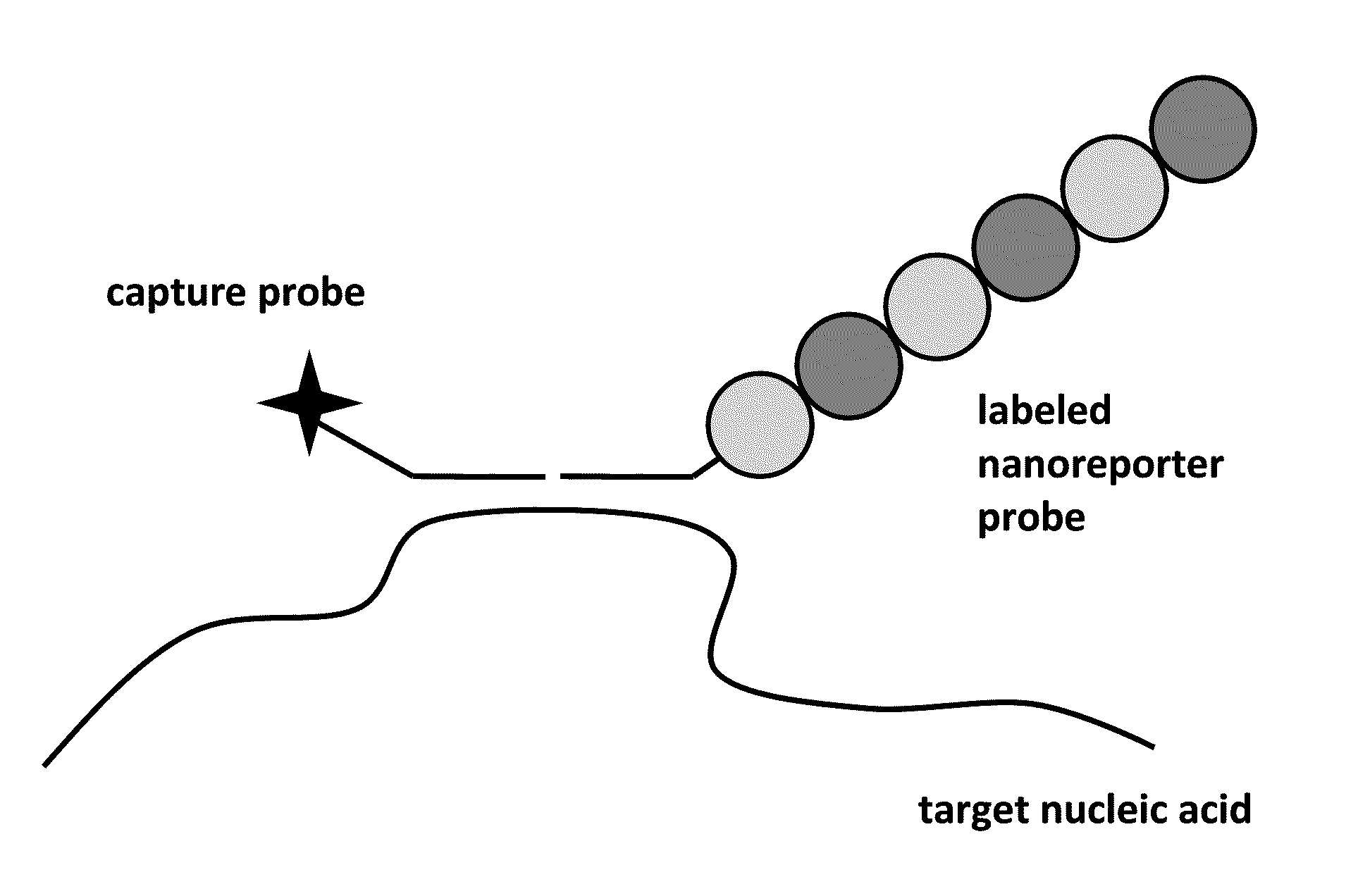Stable nanoreporters
a nano-reporter and nano-reporting technology, applied in the field of stable nano-reporters, can solve the problems of insufficient supply of biological samples, method still requires significant amounts of biological samples, and the kinetics of hybridization on the surface of a microarray are less efficient than hybridization
- Summary
- Abstract
- Description
- Claims
- Application Information
AI Technical Summary
Benefits of technology
Problems solved by technology
Method used
Image
Examples
example 1
Design and Manufacturing Protocol for a De Novo 1 (DV1) Nanoreporter Backbone Library
[0247]To construct a library of diverse Nanoreporter backbones, label attachment regions were selected from a library of unique, rationally designed polynucleotide sequences and cloned in various combinations into a plasmid vector having the polynucleotide sequence set forth in SEQ ID NO:27. This vector sequence does not end up in the final reporter backbone, but is utilized for cloning and propagating the backbone sequences.
[0248]Specifically, each unique, code-specific DV1 plasmid was constructed of six approximately 1100 base pair label attachment regions, which were selected from the polynucleotide sequences of SEQ ID NOS:1-24. The label attachment regions defined by these polynucleotide sequences were cloned in various combinations into the vector of SEQ ID NO:27, each label attachment region corresponding to a fixed position on a given backbone, i.e., position 1, position 2, through position 6...
example 2
Generating Dye-Colored Complementary RNA Polynucleotides
[0252]In vitro transcription (IVT) reactions were utilized to generate amino-allyl modified complementary RNA polynucleotides using MEGAscript T3, T7 or SP6 kits (Ambion™), following the manufacturer's instructions with the following specifics and modifications.
[0253]Plasmids containing an RNA polymerase promoter and the polynucleotide sequence of interest were linearized by restriction digestion, ethanol-precipitated and used as templates. In this example, the sequences set forth in SEQ ID NOS:1-24 were used as templates in the IVT reaction, generating 24 unique complementary RNA polynucleotides.
[0254]Amino-allyl-UTP (aaUTP) (Fermentas) was substituted for the UTP supplied in the kit, or a mixture of aaUTP and the supplied UTP was used. The level of dye-incorporation in a complementary RNA polynucleotide correlates with the number of possible amino-allyl (aa) attachment sites. To make the brightest possible colored segments, 1...
example 3
Generating a Labeled DV1 Nanoreporter Library
[0258]To produce a library of labeled DV1 Nanoreporter molecules, each code-specific DNA backbone from Example 1 was ligated separately to a probe region, i.e., target-specific nucleotide sequence, for a specific gene of interest. The probe was ligated to the backbone via an oligonucleotide, which serves as a bridge between the backbone and the specific probe. Specifically, a master mix containing a universal oligonucleotide that served as a ligation “bridge” plus ligase buffer was added to individual wells of 96-well plates containing normalized (10 μM) target-specific oligonucleotide probes (35-50 bases). After a short incubation at 37° C. to anneal the probe oligonucleotide to the complementary portion of the bridge oligonucleotide, ligation was initialized by addition of 1.2 pmoles of individual single-stranded nanoreporter backbone per well, additional ligation buffer, and T4 ligase. Plates were incubated at 37° C. in a 96-well therm...
PUM
| Property | Measurement | Unit |
|---|---|---|
| Tm | aaaaa | aaaaa |
| Tm | aaaaa | aaaaa |
| Tm | aaaaa | aaaaa |
Abstract
Description
Claims
Application Information
 Login to View More
Login to View More - R&D
- Intellectual Property
- Life Sciences
- Materials
- Tech Scout
- Unparalleled Data Quality
- Higher Quality Content
- 60% Fewer Hallucinations
Browse by: Latest US Patents, China's latest patents, Technical Efficacy Thesaurus, Application Domain, Technology Topic, Popular Technical Reports.
© 2025 PatSnap. All rights reserved.Legal|Privacy policy|Modern Slavery Act Transparency Statement|Sitemap|About US| Contact US: help@patsnap.com



